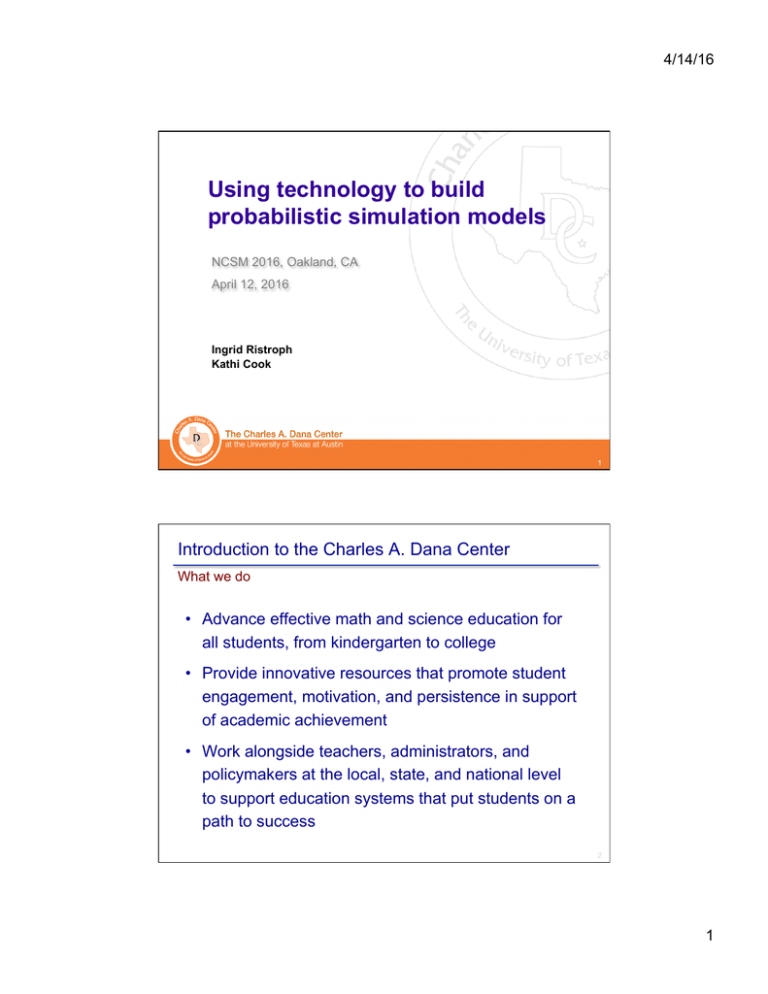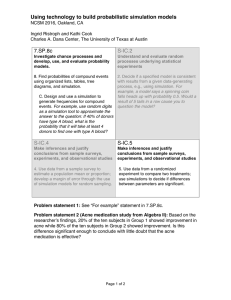Using technology to build probabilistic simulation models
advertisement

4/14/16 Using technology to build probabilistic simulation models NCSM 2016, Oakland, CA April 12, 2016 Ingrid Ristroph Kathi Cook 1 Introduction to the Charles A. Dana Center What we do • Advance effective math and science education for all students, from kindergarten to college • Provide innovative resources that promote student engagement, motivation, and persistence in support of academic achievement • Work alongside teachers, administrators, and policymakers at the local, state, and national level to support education systems that put students on a path to success 2 1 4/14/16 Introduction: What are simulations? ! A simulation is a way to model random events, such that simulated outcomes closely match real-world outcomes. ! Simulations can involve physical materials (such as drawing numbers from a bag, tossing a coin, spinning a spinner) or generating data on a computer (such as generating random numbers to represent samples from a population). 3 Selected standards 7.SP.8c S-IC.2 Investigate chance processes and develop, use, and evaluate probability models. Understand and evaluate random processes underlying statistical experiments 8. Find probabilities of compound events using organized lists, tables, tree diagrams, and simulation. c. Design and use a simulation to generate frequencies for compound events. For example, use random digits as a simulation tool to approximate the answer to the question: If 40% of donors have type A blood, what is the probability that it will take at least 4 donors to find one with type A blood? 2. Decide if a specified model is consistent with results from a given data-generating process, e.g., using simulation. For example, a model says a spinning coin falls heads up with probability 0.5. Would a result of 5 tails in a row cause you to question the model? S-IC.4 S-IC.5 Make inferences and justify conclusions from sample surveys, experiments, and observational studies Make inferences and justify conclusions from sample surveys, experiments, and observational studies 4. Use data from a sample survey to estimate a population mean or proportion; develop a margin of error through the use of simulation models for random sampling. 5. Use data from a randomized experiment to compare two treatments; use simulations to decide if differences between parameters are significant. ! 4 2 4/14/16 Reflecting on these standards ! What is your experience with these standards? ! What’s noteworthy? ! What challenges have you encountered related to these standards? ! What teaching strategies come to mind? 5 Explore designing and using a simulation If 40% of donors have type A blood, what is the probability that it will take at least 4 donors to find one with type A blood? How would you design and use a simulation to answer this question? Let’s see an example of a simulation built in a Google spreadsheet. 6 3 4/14/16 Explore designing and using a simulation If 40% of donors have type A blood, what is the probability that it will take at least 4 donors to find one with type A blood? In our Google spreadsheet simulation, we used three commands: ! =RANDBETWEEN(0,9) ! =OR(C1<4,C2<4, C3<4) ! =COUNTIF(B1:B200, TRUE) 7 Technology for simulations ! ! ! ! ! Graphing calculators RNGs either on calculators or online Spreadsheets Online applets Statistical packages or computer algebra systems 8 4 4/14/16 Embedded simulation in online course materials* Acne medication study *Example from Dana Center/Agile Mind Algebra II online course program 9 Implications ! How do you ensure teachers have the time and space to understand these standards? ! What is the role of simulation in building student and teacher understanding of statistical concepts? ! What are the implications for curriculum and materials? 10 5 4/14/16 Conclusion ! Simulations are powerful for building statistical understanding for two key concepts: randomness and variation. ! These concepts are the foundations of the Law of Large Numbers, Central Limit Theorem, confidence intervals, hypothesis testing, and regression coefficients. ! Building simulations is a fun way to integrate coding into curriculum! 11 Want to learn more? Ingrid Ristroph ingrid.ristroph@austin.utexas.edu Kathi Cook klcook@austin.utexas.edu On Twitter @IngridRistroph and @UTDCKathi Follow the Dana Center on Twitter @utdanacenter 12 6





